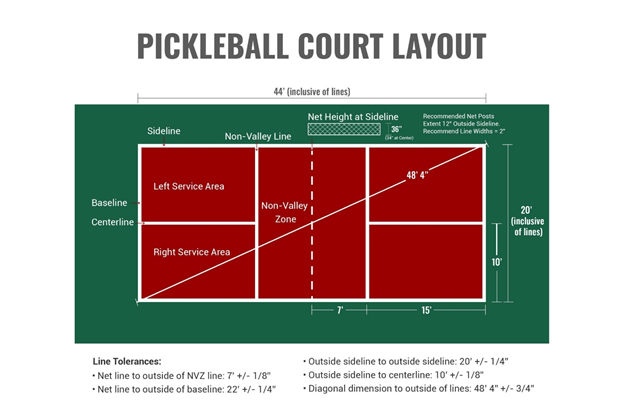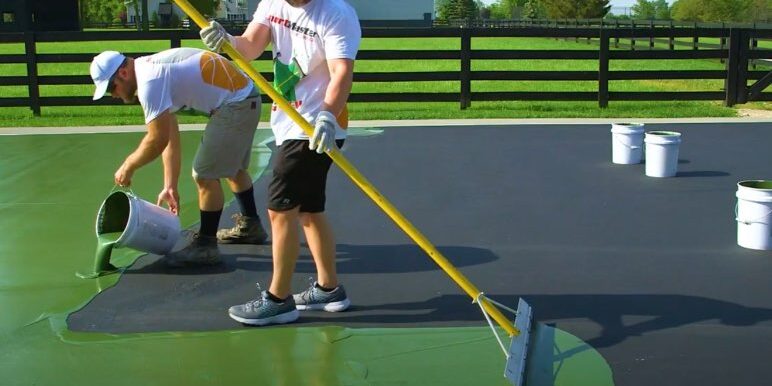Economical Pickleball Court Construction for Residences and Communities
Economical Pickleball Court Construction for Residences and Communities
Blog Article
Sustainable Practices in Pickleball Court Construction You Must Know
As the appeal of pickleball proceeds to increase, so too does the demand for lasting techniques in court building. The effect of these techniques prolongs far past the court itself.
Picking Eco-Friendly Products
Choosing environmentally friendly materials is a critical action in the building and construction of lasting pickleball courts. The selection of sustainable materials not just reduces ecological impact yet also boosts the durability and efficiency of the court. Trick materials include recycled rubber for the surface, which supplies superb sturdiness and shock absorption while diverting waste from landfills.
Additionally, utilizing locally sourced materials lowers transport discharges and supports local economic climates. Pickleball court construction. Utilizing indigenous hardwoods for secure fencing and seating can supply a lasting aesthetic while making certain durability against the elements.
Integrating absorptive materials for court structures can better add to sustainability by enabling all-natural water drain and minimizing overflow. These options not only safeguard local communities but likewise promote healthier play settings.
Efficient Water Drainage Solutions
While the option of environmentally friendly materials is crucial, executing reliable water drainage solutions is equally essential for preserving lasting pickleball courts. Appropriate drain not just shields the court surface area from water damages yet also reduces erosion and overflow, advertising environmental stability.
Effective drain systems can include absorptive paving, which permits water to infiltrate the ground instead of merging externally. This decreases the probability of standing water, which can lead to mold and various other upkeep problems. In addition, integrating tactically placed water drainage channels and swales can route excess water away from the court area, making sure a dry having fun surface and protecting against soil disintegration.
Making use of indigenous vegetation in the landscaping around the courts can additionally boost drainage by soaking up excess water and reducing runoff. These plants call for less watering and promote biodiversity, aligning with sustainable methods.
Moreover, it is important to routinely maintain the drainage system to ensure its lasting performance. This consists of clearing particles and monitoring for obstructions. By prioritizing reliable drainage services, pickleball court erectors can considerably add to the sustainability and durability of the facility, inevitably benefiting both gamers and the setting.
Energy-Efficient Lighting Options
As the demand for pickleball remains to grow, integrating energy-efficient lighting alternatives into court layout has come to be progressively essential for sustainability. Traditional illumination systems usually consume excessive power, adding to higher functional costs and ecological impact. As a result, taking on contemporary, energy-efficient technologies is important for both brand-new building and constructions and restorations.
LED (Light Emitting Diode) lights attracts attention as a top choice because of its longevity and energy cost savings (Pickleball court construction). Contrasted to traditional illumination, LEDs utilize roughly 75% much less energy and can last approximately 25 times much longer, dramatically lowering upkeep prices. In addition, the directional nature of LED lights minimizes light pollution, ensuring that lighting is concentrated on the court as opposed to surrounding locations.

Sustainable Surface Area Alternatives
Checking out sustainable surface area alternatives for pickleball courts has obtained grip amongst gamers and home builders alike. The focus on environmentally friendly materials not only straightens with the growing ecological awareness yet also improves the efficiency and resilience of the courts.
This material supplies superb shock absorption, reducing the risk of injuries for players while advertising sustainability. These floor tiles are very easy to mount and replace, and their versatility allows for numerous court setups.
Natural yard courts are additionally becoming a sustainable selection, advertising biodiversity and minimizing the heat island effect. They require normal maintenance and water, which may not straighten with all sustainability goals.

Water Conservation Strategies

Another reliable technique includes the installment of rainwater harvesting systems. These systems save and collect rain for usage in maintaining court surfaces and landscape design. This strategy not just preserves drinkable water but additionally minimizes dependence on municipal sources.
Additionally, using drought-resistant landscaping around the courts is necessary. Native plants call for less water and are better adapted to regional climate conditions, therefore reducing total water usage. Furthermore, utilizing reliable watering systems, such as drip watering, makes sure that water is provided directly to plant roots, reducing evaporation and waste.
Conclusion
Integrating sustainable practices in pickleball court construction considerably contributes to ecological conservation and resource efficiency. Using environment-friendly products, carrying out efficient drain services, and adopting energy-efficient illumination options can greatly lower environmental impact. Exploring sustainable surface alternatives and utilizing water preservation strategies improve the general sustainability of these leisure facilities. By prioritizing these methods, the construction of check my site pickleball courts can line up with more comprehensive environmental objectives while advertising long life and capability within neighborhoods.
As the appeal of pickleball continues to increase, so also does the need for lasting methods in court building and construction.Selecting environmentally friendly products is an important step in the construction of sustainable pickleball courts. By prioritizing energy-efficient lighting options, pickleball court producers can contribute to a more lasting future while meeting the needs of players and stakeholders alike.Incorporating visit lasting surface area alternatives not only enhances the efficiency of pickleball courts however additionally paves the means for implementing effective water preservation techniques.Incorporating sustainable practices in pickleball court construction dramatically contributes to ecological preservation and resource efficiency.
Report this page